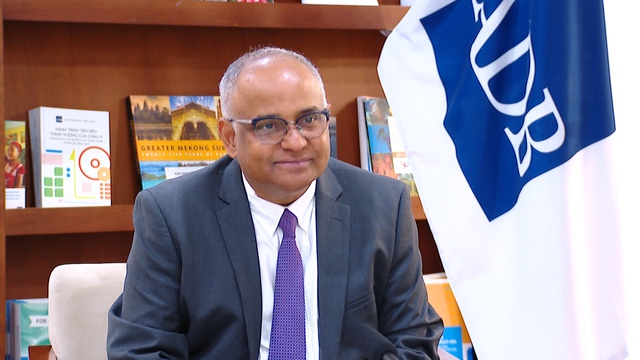A Rising Star in Asia
With many initiatives in promising disciplines like energy, marine or space sciences, Vietnam asserts its ambition to quickly become a knowledge-based economy with an international scope. The country is thus emerging as a much sought-after scientific partner.
Making its centralized administration more flexible and joining the race in the highly-competitive global knowledge market: this is the challenge that Vietnam is taking on today. Alongside traditional disciplines like physics, chemistry, and mathematics, the country is developing new research fields of international interest, including space research, marine sciences, nanotechnology, and materials sciences, with promising and sometimes even spectacular results. Space science provides a good illustration. In 2008, barely two years after the Space Technology Institute was set up by the Vietnam Academy of Science and Technology (VAST), the country achieved an outer space milestone with the launch of its first telecommunications satellite from Kourou (French Guiana). Three years later, VAST followed up on this success by opening the Vietnam National Satellite Center, which scored another triumph in May 2013, again from Kourou, when Vietnam’s first environmental monitoring satellite was put into orbit.
Vietnams VNREDSat 1 satellite was launched by the ESAs Vega rocket from Kourou (French Guiana) in May 2013
The country’s admission to the World Trade Organization (WTO) in 2007 sped up reforms, also affecting the country’s scientific governance. A national re-search-funding agency was set up by the Ministry of Science and Technology (MoST), along with a close-knit network of regional offices and of information, orientation, evaluation, and technology transfer structures
UNIVERSITY PARTNERSHIPS
In addition to established research institutions like VAST, Vietnam opened public universities with international ambitions over the last 5 years. Among these, the Vietnamese-German University (VGU) in Ho Chi Minh City was founded in 2008. Similarly, the University of Science and Technology of Hanoi (USTH) was launched in cooperation with France in 2009. In 2010, the USTH began offering its French-Vietnamese curriculum on the VAST campus in Hanoi, pending completion of its own buildings, scheduled for 2018. The future campus, located in the Hoa Lac technology park, 30 kilometers west of Hanoi, will welcome some 2000 students and boast programs in six key scientific fields: biotechnology, nanomaterials, water and the environment, information technology, energy, and space.
HISTORIC TIES
France is one of Vietnam’s most valued scientific partners. The historic ties between the two countries were strengthened in 2007 with the signing of an initial scientific and technological cooperation agreement, followed in 2009 by a second agreement promoting the use of nuclear energy for peaceful purposes. A partnership between the MoST in Vietnam and the French Ministries of Foreign Affairs (MAE) and Education and Research (MESR), the Hubert Curien program “Hoa Sen Lotus” represents another important collaboration between the two countries. Its goal is to promote technological and scientific exchanges through young researcher transfer programs. Between 2011 and 2012, a dozen projects were selected (nine of which involve CNRS), covering topics such as rice viruses, nanomaterial’s for catalysis, or new methods for environmental detection in coal mines. Vietnam’s scientific potential and human talent have long been known to French research organizations, especially CNRS, CIRAD, and IRD, which gathered their representative offices in 2009 in the Van Phuc diplomatic compound. This summer, CNRS and VAST will be celebrating 30 years of cooperation. The president of VAST and five of its institute directors will meet at CNRS headquarters in Paris to mark the occasion. They will also review the highlights of this collaboration, including the 1997 launch of the Do Son annual schools. Focused on a specific scientific area each year, the schools host some 50 Vietnamese researchers and students, as well as a dozen French scientists in the seaside resort of Do Son to disseminate knowledge and bring together teams with close scientific affinities. Naturally, on this anniversary, CNRS and VAST will also discuss future projects. Chemistry remains one of the most fruitful collaboration areas between both countries, with five existing agreements in this field, including three with VAST on phytochemistry, corrosion, and the environment. Mathematics is also prominent, through the ForMATH international associated laboratory (LIA) and an international research network (GDRI) in mathematical singularities. Other promising research projects have been initiated, especially in marine sciences, space, and biodiversity conservation. Riding on this momentum, a LIA in nanomaterials should soon be created.
ACTIVE RESEARCH
In all, no fewer than six LIAs, two GDRIs, and four international programs for scientific cooperation (PICS) are in operation in fields ranging from telecommunications to anthropology. Yet CNRS’s flagship collaboration is the International Joint Unit (UMI) on Multimedia, Information, Communication and Applications (MICA, see box), a partner-ship between the Hanoi University of Science and Technology (HUST), the Grenoble Institute of Technology (Grenoble INP), and CNRS. New collaborations in cross-cutting disciplines are also underway, like the GDRI on biodiversity and infectious diseases, or the LIA in petro chemistry launched in 2004, involving CNRS (IRCELYON laboratory) and the Vietnam Institute of Industrial Chemistry (VIIC). Dedicated to the development of latest-generation biofuels, the collaboration filed its first patent in 2010. The next 30 years look promising for French-Vietnamese cooperation.
source: CNRS Networks
More Articles
- • Delegation of METI-Kansai visited HHTP
- • Highlights of Vietnam-Japan sci-tech cooperation
- • Update current condition of some projects under construction in HHTP
- • Foreign Affairs Minister of Ecuador visited HHTP
- • VN eyes high-tech cooperation with Japan
- • Telesens International Ltd looked for investment cooperation opportunities
- • SEA-EU-NET experts worked with HHTP
- • Finnish expert group assess and build up Phase 2 for IPP project
- • Chairman of Forlì-Cesena’s Chamber of Commerce visited HHTP
- • Minister of Ministry of Science and Technology visited Hoa Lac Hi-tech Park



